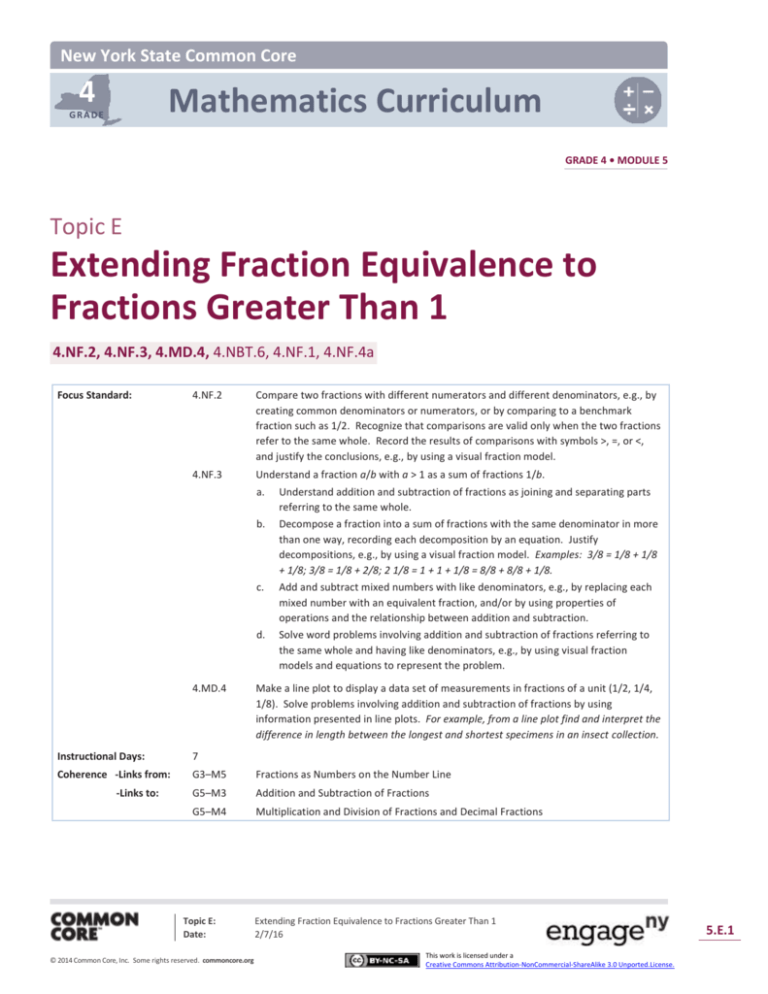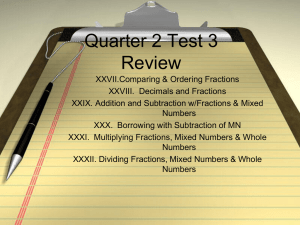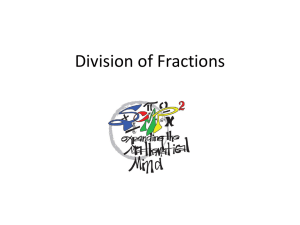
New York State Common Core
4
Mathematics Curriculum
GRADE
GRADE 4 • MODULE 5
Topic E
Extending Fraction Equivalence to
Fractions Greater Than 1
4.NF.2, 4.NF.3, 4.MD.4, 4.NBT.6, 4.NF.1, 4.NF.4a
Focus Standard:
4.NF.2
Compare two fractions with different numerators and different denominators, e.g., by
creating common denominators or numerators, or by comparing to a benchmark
fraction such as 1/2. Recognize that comparisons are valid only when the two fractions
refer to the same whole. Record the results of comparisons with symbols >, =, or <,
and justify the conclusions, e.g., by using a visual fraction model.
4.NF.3
Understand a fraction a/b with a > 1 as a sum of fractions 1/b.
4.MD.4
a.
Understand addition and subtraction of fractions as joining and separating parts
referring to the same whole.
b.
Decompose a fraction into a sum of fractions with the same denominator in more
than one way, recording each decomposition by an equation. Justify
decompositions, e.g., by using a visual fraction model. Examples: 3/8 = 1/8 + 1/8
+ 1/8; 3/8 = 1/8 + 2/8; 2 1/8 = 1 + 1 + 1/8 = 8/8 + 8/8 + 1/8.
c.
Add and subtract mixed numbers with like denominators, e.g., by replacing each
mixed number with an equivalent fraction, and/or by using properties of
operations and the relationship between addition and subtraction.
d.
Solve word problems involving addition and subtraction of fractions referring to
the same whole and having like denominators, e.g., by using visual fraction
models and equations to represent the problem.
Make a line plot to display a data set of measurements in fractions of a unit (1/2, 1/4,
1/8). Solve problems involving addition and subtraction of fractions by using
information presented in line plots. For example, from a line plot find and interpret the
difference in length between the longest and shortest specimens in an insect collection.
Instructional Days:
7
Coherence -Links from:
G3–M5
Fractions as Numbers on the Number Line
G5–M3
Addition and Subtraction of Fractions
G5–M4
Multiplication and Division of Fractions and Decimal Fractions
-Links to:
Topic E:
Date:
© 2014 Common Core, Inc. Some rights reserved. commoncore.org
Extending Fraction Equivalence to Fractions Greater Than 1
2/7/16
This work is licensed under a
Creative Commons Attribution-NonCommercial-ShareAlike 3.0 Unported.License.
5.E.1
Topic E 4 5
NYS COMMON CORE MATHEMATICS CURRICULUM
In Topic E, students study equivalence involving both ones and fractional units. In Lesson 22, they use
decomposition and visual models to add and subtract fractions less than 1 to and from whole numbers,
3
3
3
3
e.g., 4 + 4 = 4 4 and 4 – 4 = (3 + 1) – 4, subtracting the fraction from 1 using a number bond and a number line.
Lesson 23 has students use addition and multiplication to build fractions greater than 1 and then represent
them on the number line. Fractions can be expressed both in mixed units of a whole number and a fraction
1
3
3
1
3
1
7
1
or simply as a fraction, as pictured below, e.g., 7 × 3 = 3 + 3 + 3 = 2 × 3 + 3 = 3 = 2 3.
In Lessons 24 and 25, students use decompositions to reason about the various equivalent forms in which a
fraction greater than or equal to 1 may be presented, both as fractions and as mixed numbers. In Lesson 24,
they decompose, for example, 11 fourths into 8 fourths and 3 fourths,
4 4 3
+ +
4 4 4
4
4
3
4
11 8 3
= + ,
4
4 4
or they can think of it as
11
=
4
3
4
= 2 × + = 2 . In Lesson 25, students are then able to decompose the two wholes into 8 fourths so
8
3
11
3
11
their original number can then be looked at as 4 + 4 or 4 . In this way, they see that 2 4 = 4 . This fact is further
reinforced when they plot
11
4
3
on the number line and see that it is at the same point as 2 4. Unfortunately, the
term improper fraction carries some baggage. As many have observed, there is nothing improper about an
improper fraction. Nevertheless, as a mathematical term, it is useful for describing a particular form in which
a fraction may be presented (i.e., a fraction is improper if the numerator is greater than or equal to the
denominator). Students do need practice in terms of converting between the various forms a fraction may
take, but take care not to foster the misconception that every improper fraction must be converted to a
mixed number.
Students compare fractions greater than 1 in Lessons 26 and 27. They begin by using
their understanding of benchmarks to reason about which of two fractions is greater.
This activity builds on students’ rounding skills, having them identify the whole numbers
and the halfway points between them on the number line. The relationship between
the numerator and denominator of a fraction is a key concept here as students consider
relationships to whole numbers, e.g., a student might reason that
Topic E:
Date:
© 2014 Common Core, Inc. Some rights reserved. commoncore.org
23
8
is less than
Extending Fraction Equivalence to Fractions Greater Than 1
2/7/16
This work is licensed under a
Creative Commons Attribution-NonCommercial-ShareAlike 3.0 Unported.License.
5.E.2
Topic E 4 5
NYS COMMON CORE MATHEMATICS CURRICULUM
29
23
because 8 is
10
29
1 eighth less than 3, but 10 is 1 tenth less than 3. They know each fraction is 1 fractional unit
1
1
away from 3, and since 8 > 10, then
23
8
29
< 10. Students progress to finding and using like denominators to
compare and order mixed numbers. Once again, students must use reasoning skills as they determine that,
when they have two fractions with the same numerator, the larger fraction will have a larger unit (or smaller
denominator). Conversely, when they have two fractions with the same denominator, the larger one will
have the larger number of units (or larger numerator).
Lesson 28 concludes the topic with word problems requiring the interpretation of data presented in line plots.
Students create line plots to display a given dataset that includes fraction and mixed number values. To do
this, they apply their skill in comparing mixed numbers, both through reasoning and the use of common
5
9
14
9
numerators or denominators. For example, a data set might contain both 1 and , giving students the
opportunity to determine that they must be plotted at the same point. They also use addition and
subtraction to solve the problems.
A Teaching Sequence Toward Mastery of Extending Fraction Equivalence to Fractions Greater Than 1
Objective 1: Add a fraction less than 1 to, or subtract a fraction less than 1 from, a whole number using
decomposition and visual models.
(Lesson 22)
Objective 2: Add and multiply unit fractions to build fractions greater than 1 using visual models.
(Lesson 23)
Objective 3: Decompose and compose fractions greater than 1 to express them in various forms.
(Lessons 24–25)
Objective 4: Compare fractions greater than 1 by reasoning using benchmark fractions.
(Lesson 26)
Objective 5: Compare fractions greater than 1 by creating common numerators or denominators.
(Lesson 27)
Objective 6: Solve word problems with line plots.
(Lesson 28)
Topic E:
Date:
© 2014 Common Core, Inc. Some rights reserved. commoncore.org
Extending Fraction Equivalence to Fractions Greater Than 1
2/7/16
This work is licensed under a
Creative Commons Attribution-NonCommercial-ShareAlike 3.0 Unported.License.
5.E.3









